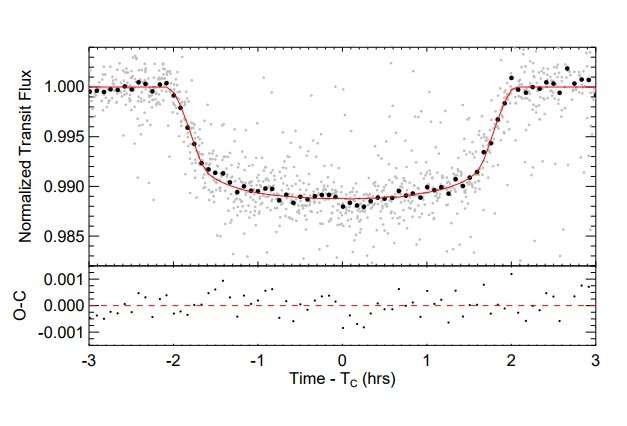December 20, 2017 report
Astronomers discover a 'hot Jupiter' orbiting a rapidly rotating star

An international team of astronomers has found a "hot Jupiter" exoplanet circling a rapidly rotating, metal-poor star. The newly discovered alien world, designated KELT-21b, is larger than Jupiter and orbits its host in less than four days. The finding is presented in a paper published December 8 on arXiv.org.
KELT-21b was discovered by a group of researchers led by Marshall C. Johnson of the Ohio State University. The astronomers used the KELT-North telescope at Winer Observatory in Arizona to observe the star KELT-21 (also known as HD 332124) as part of the Kilodegree Extremely Little Telescope (KELT) project. This survey detects transiting exoplanets around bright stars.
Johnson's team identified a transit signal in the light curve of KELT-21. The planetary nature of this signal was later confirmed by a follow-up observational campaign that employed the KELT Follow-Up Network (KFUN) consisting of various ground-based observatories worldwide.
"Here we present the discovery of a new transiting hot Jupiter, KELT-21b, confirmed using Doppler tomography," the paper reads.
The study reveals that KELT-21b has a radius of about 1.59 Jupiter radii, but its exact mass remains uncertain. The researchers only determined its upper mass limit to be approximately 3.91 Jupiter masses. KELT-21b orbits its star every 3.61 days at a distance of about 0.05 AU from the host. The planet has an equilibrium temperature of 2,051° K.
The parameters of KELT-21b show that it is an another example of a "hot Jupiter" exoplanet. The so-called "hot Jupiters" are gas giant planets, similar in characteristics to the solar system's biggest planet, with orbital periods of less than 10 days. They have high surface temperatures, as they orbit their host stars very closely.
When it comes to the host, it is a metal-poor star of spectral type A8V, with a radius of about 1.63 solar radii and nearly 46 percent more massive than the sun. The star is about 1.6 billion years old and has an effective temperature of approximately 7,600° K.
Notably, KELT-21 has a relatively very high projected rotation velocity of 146 km/s. This makes it the most rapidly rotating star known to host a transiting giant planet. KELT-21 also turns out to be one of only several known A stars to be orbited by a transiting planet.
Besides discovering and characterizing KELT-21b, Johnson's team also found two stars of about 0.12 Jupiter masses each that could be associated with KELT-21. However, they cannot confirm this finding with available data, therefore further observations are required to validate this assumption.
"Our high-resolution imaging observations revealed the presence of a close pair of faint stars at a separation of 1''.2 from the planet host star. Although we cannot confirm using our current data whether they are physically associated with the KELT-21 system, we have argued statistically that they are unlikely to be background sources," the researchers wrote in the paper.
If this hypothesis is confirmed, it would mean that KELT-21b is one of only a handful of known transiting exoplanets in hierarchical triple stellar systems.
More information: KELT-21b: A Hot Jupiter Transiting the Rapidly-Rotating Metal-Poor Late-A Primary of a Likely Hierarchical Triple System, arXiv:1712.03241 [astro-ph.EP] arxiv.org/abs/1712.03241
© 2017 Phys.org





















